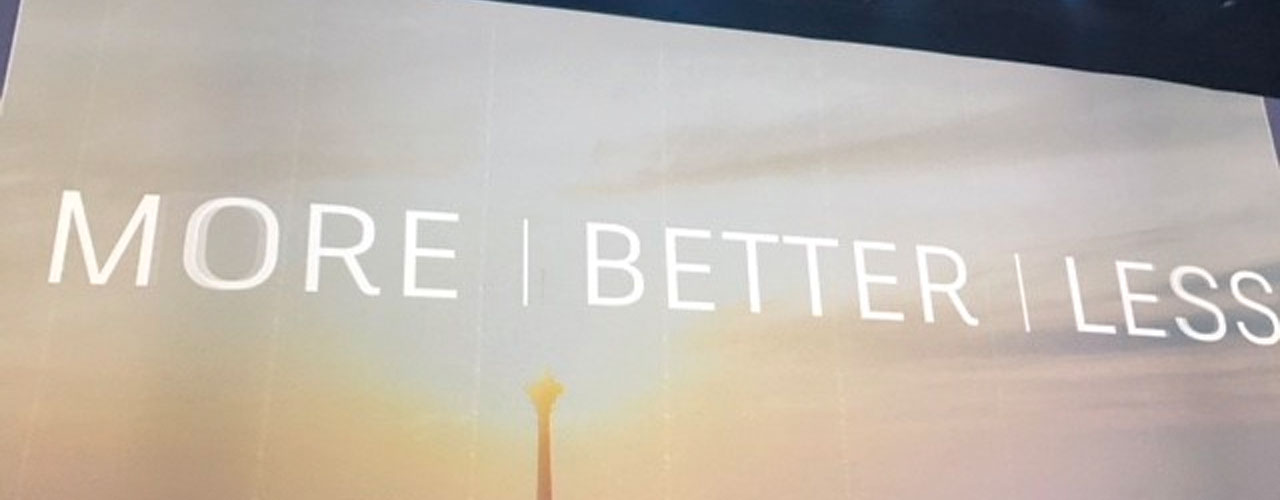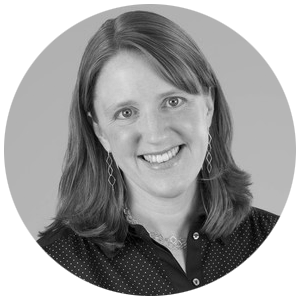BLOG
MORE | BETTER | LESS?
Why AU’s Keynote Speaker Fell Flat
Written by: Nadja Turek

Andrew Anagnost, CEO of Autodesk, delivered the opening keynote speech at Autodesk University (AU) here in Las Vegas yesterday. Emphasizing a three-word vision for the future: “MORE | BETTER | LESS,” he addressed the future of automation and attempted to ease audience concerns about being replaced by robots.
Thanks to automation, Anagnost said, workers of the future will do more, and do it better, with less—meaning, with a less-damaging footprint on the planet. Yet why, despite his positivity, was the audience’s response to his message so flat?
Throughout Anagnost’s speech, I couldn’t help but think of the phrase “do more with less,” which is worn out and fraught with negative connotation. In the wake of the recession years, “do more with less” evokes the idea that in addition to doing your own job, you’ll have to absorb several more and produce extra work with fewer resources. Personally, I’d rather do BETTER work (not necessarily more!) with MORE resources (not less!). Wouldn’t that be great? And I’m a believer that there are so many ways our industry can and will employ MORE people—but more on that in a moment.
The second area of Anagnost’s keynote address that fell flat was his reference to doing “less” damage to the environment. Framing environmentalism as doing “less bad” is an all-too-common pitfall. No one gets excited about being “less bad” to the planet. We want to be GOOD to our planet, which is the essence of sustainable design! Human presence and activity on this planet don’t have to be damaging. In fact, our collective work can enrich the planet and its inhabitants (human AND other). If our economy grows wealth and health through cyclical resource use, safely returning resources to nature and perpetually reusing them, then growth is good.
So, what should he have said?
Instead of doing “less” damage, I’d reframe the message to explain how we will enrich the environment through our design solutions and lifestyle choices. Methods for this include adopting cradle-to-cradle design (full credit to “Cradle to Cradle” authors McDonough and Braungart). And I would have liked to hear how Autodesk will help us design solutions that mimic nature’s cycles of use and reuse. If the resources we use in our designs maintain their quality and functionality, then we can either return them safely to the biome or remake them into new products without diminishment or contamination. There would be no need to do “less.”
Getting back to “more” employment—just as an organic farm employs more people to produce healthy food than a large-scale industrial farm, the application of cradle-to-cradle thinking in design and construction will lead to stronger employment. The cyclical use of materials creates the demand for both construction and deconstruction, resulting in the creation of more “green jobs” (like mine). Net-zero facilities and communities of the future will employ these green building managers in jobs that don’t currently exist.
Ultimately, “do more with less” and “less bad” were both unfortunate messaging choices that didn’t make for a strong pep talk. However, I do think the idea of doing things BETTER than we presently are is a big motivator among knowledge workers, including the audience at AU. I certainly am driven to do better and achieve greater outcomes at work, both for my clients and the communal life boat that is our planet.
So, let’s keep “better,” and I’d like to propose a substitute rubric (so I’m not just a Debbie-downer). My version goes like this: BETTER | MORE | GOOD. The future will hold better, more meaningful work for more people doing good for each other and our ecosystem. That’s the future I’m working towards—robots or not!
Check out more Woolpert blogs from AU.

Nadja Turek
Nadja Turek, a civil engineer and sustainable design expert, serves as Woolpert’s Research and Development Facilitator. As a former faculty member at the University of Dayton and the Air Force Institute of Technology, she is a sought-after teacher and speaker. Nadja has provided sustainability training to over 1,000 designers and engineers and given numerous presentations as a sustainable design expert. She currently serves as an Advocacy Chairperson for USGBC’s Cincinnati Chapter.
nadja.turek@woolpert.com